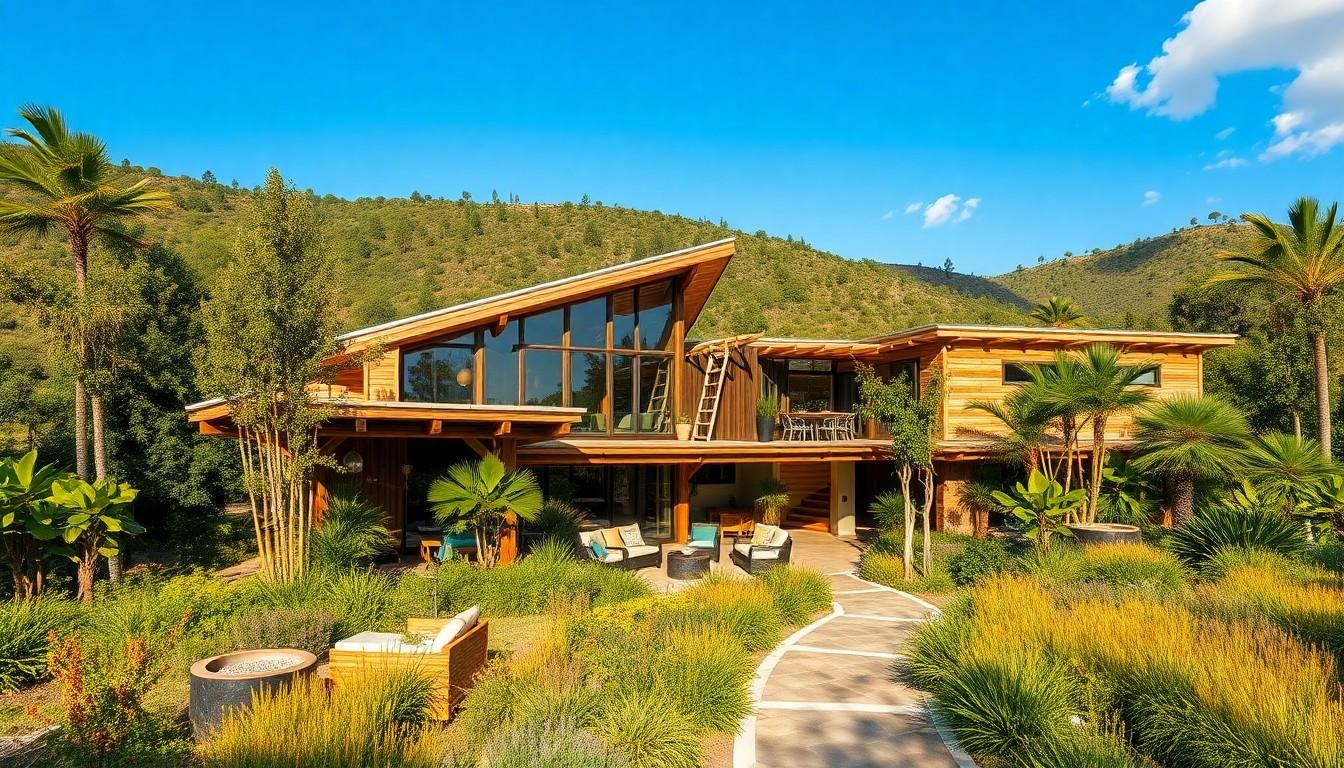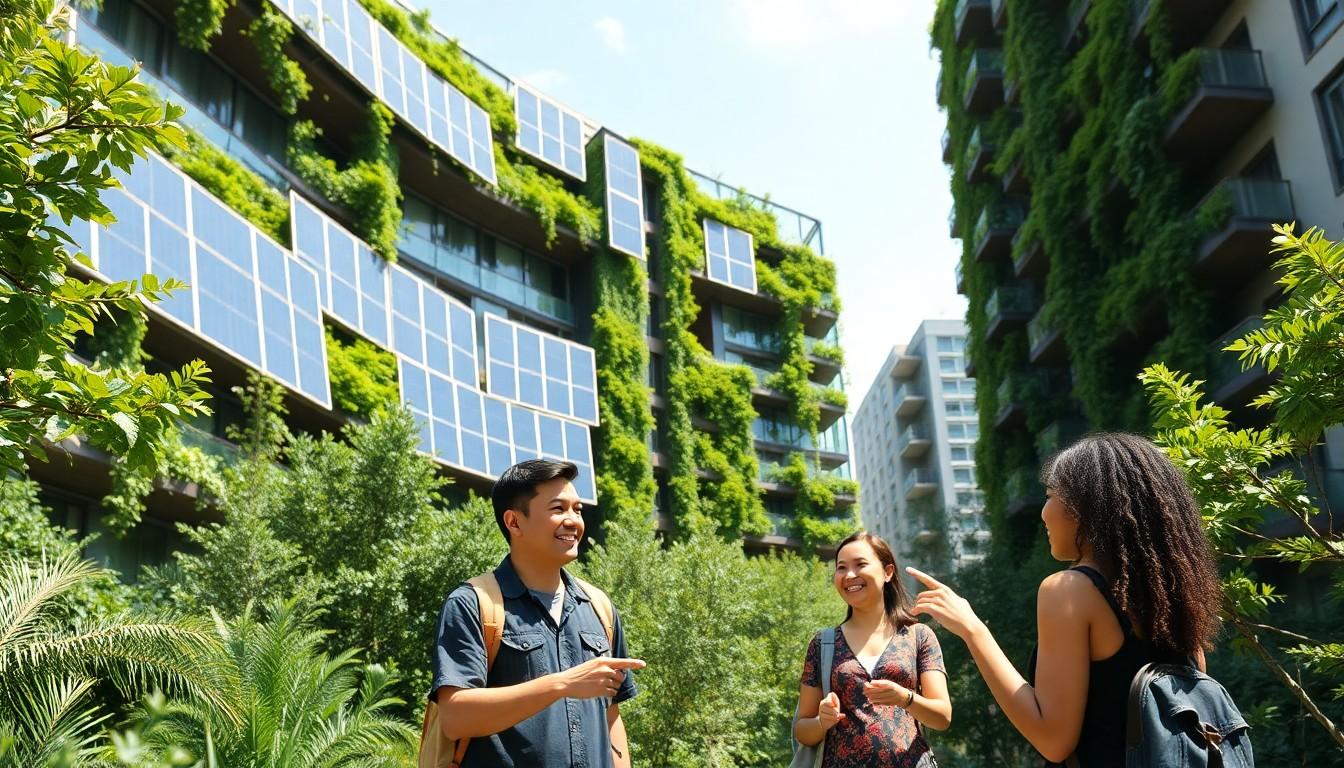Imagine a building so green it makes Mother Nature herself do a happy dance. Welcome to the most sustainable living building on Earth, where eco-friendliness meets architectural brilliance. This marvel isn’t just about looking good; it’s about living well while giving the planet a big bear hug.
From solar panels that catch rays like a sunbather to walls that breathe like a yoga master, every inch of this structure screams sustainability. It’s the place where innovation meets responsibility, proving that saving the Earth can be both stylish and fun. So grab your reusable coffee cup and get ready to dive into a world where living sustainably isn’t just a trend; it’s a lifestyle.
the most sustainable living building on earth
Sustainable living buildings emphasize eco-friendliness through innovative design and materials. These structures integrate features like solar panels, energy-efficient systems, and sustainable materials to minimize their environmental impact. Many buildings use renewable energy sources to reduce reliance on fossil fuels and limit greenhouse gas emissions.
Passive design elements enhance energy efficiency by optimizing natural light and ventilation. Breathable walls, for instance, regulate temperature and humidity without relying heavily on mechanical systems. Rainwater harvesting systems further contribute by collecting and reusing water, preserving valuable resources.
Numerous sustainable buildings showcase green roofs and walls that provide insulation while promoting biodiversity. Urban areas benefit from these designs through reduced heat islands, improved air quality, and increased green space. In addition, sustainable living buildings often incorporate recycled or reclaimed materials, contributing to a circular economy.
Community engagement plays a significant role in sustainable building projects. Developers often collaborate with local residents and organizations, ensuring that the structures align with community needs. Education programs surrounding these buildings help promote sustainable practices among occupants and visitors alike.
Investors increasingly prioritize sustainable living buildings due to their long-term financial benefits. Higher energy efficiency leads to lower operating costs, making these properties attractive in the real estate market. With a growing consumer demand for eco-friendly spaces, the trend towards sustainable living buildings continues to gain momentum.
Key Features of the Most Sustainable Living Building on Earth

This building showcases several distinctive features that make it a leader in sustainability. Each characteristic contributes to its overall eco-friendliness and design excellence.
Innovative Materials
Recycled materials play a significant role in the construction of this building. Designers utilize bamboo, reclaimed wood, and recycled steel to reduce the carbon footprint. Additionally, non-toxic paints and finishes ensure a healthier indoor environment. Natural insulation materials enhance thermal performance while decreasing energy use. Together, these elements create a structure that embodies modern sustainability practices.
Energy Efficiency
High-efficiency solar panels generate considerable energy for this building. Advanced insulation systems minimize energy loss, maintaining comfortable indoor temperatures without excessive heating or cooling. Smart home technologies adjust energy consumption based on occupancy, optimizing efficiency. Enhanced daylighting techniques reduce reliance on artificial lighting. Through these energy-saving strategies, the building achieves an impressive reduction in utility costs year-round.
Water Conservation
Rainwater harvesting systems collect and reuse precipitation for irrigation and non-potable uses. Low-flow plumbing fixtures minimize water consumption without sacrificing performance. Native landscaping requires less irrigation, further conserving water resources. Greywater recycling systems treat and reuse effluent from sinks and showers. Overall, these sustainable water practices significantly reduce the building’s water impact on the surrounding environment.
Impact on the Environment
This living building plays a significant role in reducing its ecological footprint. Using innovative materials like bamboo and reclaimed wood, it minimizes the reliance on new resources. Solar panels on the roof harness renewable energy, significantly cutting carbon emissions. Advanced insulation systems further enhance energy efficiency, maintaining comfortable indoor temperatures without excessive energy use.
Rainwater harvesting systems contribute to water conservation, collecting precious resources for irrigation and non-potable applications. Low-flow plumbing fixtures reduce overall water consumption, promoting sustainability in daily living. Greywater recycling systems ensure that water is reused effectively, highlighting resourcefulness in design.
Green roofs and walls not only improve aesthetics but also contribute to urban biodiversity, supporting local flora and fauna. These features enhance air quality and create habitats for wildlife in urban settings. By reducing heat islands, the building helps mitigate climate change effects in surrounding areas.
Community engagement remains a cornerstone of its design philosophy. Involving local residents in the planning process ensures that their needs are met, fostering a sense of ownership and responsibility towards the environment. Developers recognize that sustainable living buildings attract investors seeking long-term financial benefits, appealing to a growing consumer market focused on eco-friendly spaces.
Ultimately, the most sustainable living building on Earth exemplifies how architecture can harmonize with nature, promoting a lifestyle that prioritizes environmental stewardship.
Challenges and Considerations
Sustainable living buildings face various challenges. Initial funding often presents a significant barrier for developers seeking to implement eco-friendly designs. Investors may hesitate to finance projects that prioritize sustainability, impacting overall project viability.
Building codes complicate matters, as regulations often do not fully support innovative green technologies. Adapting these codes to accommodate advanced materials and systems can prove difficult, requiring advocacy and collaboration with local authorities. Without adjustments, projects risk non-compliance, potentially delaying timelines and incurring additional costs.
Sourcing sustainable materials adds another layer of complexity. Materials like bamboo and reclaimed wood may face availability issues or increased costs, depending on the region. Supply chain disruptions can hinder progress, especially for projects relying on specific eco-friendly resources.
Community engagement plays a crucial role in these projects. Understanding local priorities and preferences helps ensure that buildings meet the needs of residents. Fostering trust may require transparent communication and efforts to involve community members from the planning phase.
Environmental performance monitoring is essential for sustainable buildings. Implementing technologies for tracking energy use, water consumption, and indoor air quality allows for ongoing improvements. Data collection demands investment in monitoring systems but ultimately enhances operational efficiency.
Balancing cost and sustainability is vital for long-term success. Operating expenses must align with eco-friendly features to justify initial investments. Prioritizing smart technologies can enhance financial feasibility by reducing utilities and minimizing waste.
Ultimately, addressing these challenges requires collaboration among developers, local governments, and communities. Prioritizing innovative practices ensures that sustainable living buildings can thrive and continue influencing positive change in urban planning.
Future of Sustainable Living Architecture
Sustainable living architecture is evolving rapidly. Innovations in materials will lead to more efficient structures. Technologies such as artificial intelligence and machine learning can optimize energy consumption in real-time. Researchers explore biodegradable construction materials, which further reduce environmental impact.
Adaptive reuse is gaining traction, allowing old buildings to transform into sustainable spaces. Urban farming initiatives are integrating green spaces into city designs. These initiatives promote biodiversity and improve air quality. Sustainable transportation options, like electric vehicle charging stations, are becoming common features in design plans.
Collaboration among stakeholders is essential for future developments. Developers, local governments, and communities must work together to identify needs. Engaging residents in the design process ensures buildings cater effectively to local priorities. Financial incentives from local authorities can help overcome initial funding barriers.
Monitoring environmental performance offers opportunities for continuous improvement. Technology can facilitate real-time analysis of energy and water usage. Data collected can identify trends and drive effective decision-making. This approach supports long-term viability and efficiency.
The impact of building codes on sustainable architecture remains significant. Regulations must adapt to encourage innovative technologies. Without supportive policies, progress toward sustainability can stall. Advocacy for updated building codes benefits the entire community.
Ultimately, the future of sustainable living architecture relies on innovative approaches and strategic collaborations. Prioritizing eco-friendly practices sustains both the environment and community wellbeing. Each effort contributes to a greener, healthier world.
responsibility and community well-being
The most sustainable living building on Earth sets a remarkable standard for eco-friendly architecture. By embracing innovative materials and technologies it showcases how sustainability can enhance both aesthetics and functionality. As communities become more engaged in these projects the potential for positive environmental impact grows exponentially.
Investors are recognizing the long-term benefits of sustainable living spaces which leads to a shift in how buildings are designed and constructed. The ongoing evolution of sustainable architecture not only addresses current challenges but also paves the way for a greener future. Each initiative contributes to a healthier planet fostering a lifestyle that prioritizes both environmental responsibility and community well-being.

